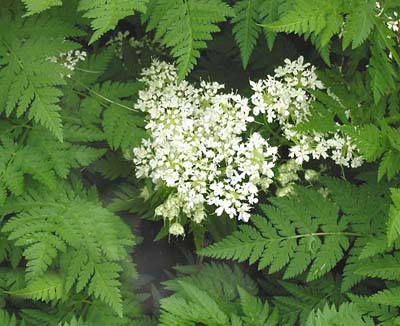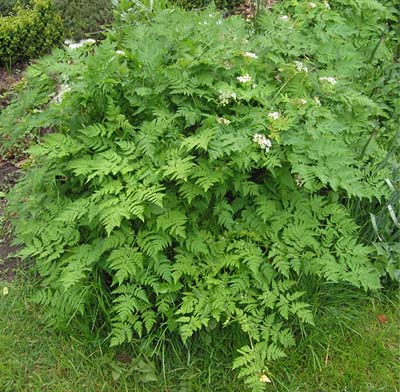A lovely delicate annual plant for cool shady locations. Excellent in pots for shady decks, window boxes and woodland gardens. It has delicate ferny foliage and small white flowers. It cannot tolerate heat and needs good rich soil to grown well. The leaves have a delicate flavor that is described differently by different people most say slightly anise with a hint either pepper, licorice or parsley. It is considered as a gourmet herb.
Description.
Mostly considered as a hardy annual but in some places listed as a biannual.
The plant will sometimes over winter if the winters are mild. It grows to the
height of about 6" for the leaves which are very fern like (tripinnate
) and delicate in appearance. The leaves can resemble parsley but are much lighter
in color and more feathery. They can be either curled or flat. The foliage has
a subtle anise flavor with a slight hint of pepper. Given suitable conditions
the plant can spread to about 12 - 14 inches across and in early summer will
send up long thin stalks, up to 18 inches tall, that are topped with clusters
or umbels of small white flowers up to 2 inches (5 cm) across.
Growing.
Chervil seed must be fresh to germinate, seeds can will only remain viable for
just over a year. Chervil is best sown directly where it is to grow as it develops
a long taproot and does not take to transplants, it tends to bolt if it takes
at all. However if grown carefully in pots and transplanted with the soil ball
or in a peat pot they can be easily started indoors for a quicker start with
less weeding. For outdoors sow in early spring and repeat every few weeks until
it becomes warm, so a steady supply of leaves is available. Plant seeds about
1" deep, keep moist, thin to about 6-8" apart when they are about
1" tall. In cooler locations plants can be seeded later. Plants can tolerate
mild frosts so can be seeded very early in the spring, or in mild climates from
October on through winter. Chervil can also be grown in planters as long as
the pot is tall enough to allow for the long taproot.
Location and care.
Chervil prefers cooler weather so it is best located in a shaded position. A
shaded location under deciduous trees or on the north side of a building is
ideal. In hot dry conditions the plants tend to bolt quickly. It prefers a good
rich well drained soil that does not become water logged. It also likes a good
deal of water. High organic material and additions of organic fertilizer will
keep the leaves rich and lush for cutting. It will tolerate a range of pH from
mildly acid to alkaline (5.0 to 8.2)
Keep the center of the stem trimmed down to encourage more leaf growth for harvesting.
Growing in containers - Chervil is an excellent pot plant for shady decks, patios and woodland gardens. The fern like foliage gives a lush look to any planter and does well combined with pansies or impatiens. Provide a good mix of organic material along with potting soil to ensure good growth. Chervil is also good in north facing window boxes and indoor pots, it makes a good short term house plant as it does not need to be directly in the window of the room but back in the cool shade. Plastic pots are best to ensure that the soil stays moist and cool, keep watered regularly. It is an excellent winter pot plant and can make a great house gift. Care for as you would a fern and it will grow well.
Companion planting
Chervil is a companion plant to radishes and is said to enhance their flavor
if planted next to them. It reportedly also protects lettuce from ants.
Harvest and Preservation
The leaves can be harvested when the plant reaches 6" (15cm) tall and can
be continued throughout the growing season, cut from the center to encourage
new leaf growth. Harvest only fresh green leaves, as they age the leaves turn
bronze and lose their delicate flavor. The leaves should be picked just before
use as they do not store well in the refrigerator. Add to dishes as the last
moment as the flavor is quickly destroyed or overpowered by other ingredients.
For later use the leaves should be washed, blanched very quickly in boiling
water, chill in ice water then chop the leaves. These can then either be frozen
on cookie sheets and stored in freezer bags. Use within two months or the leaves
will dry out For the best results frozen in water in ice cubes trays to preserve
the flavor. . Once the ice cubes are set transfer to a plastic freezer bag or
box to for storage to prevent freezer contamination. Use iced chervil within
6 months.
Drying is not recommended as the leaves lose their flavor and aroma.
Leaves can also be added to white wine vinegar to preserve them. This method
allows for the longest preservation time, but limits some recipes that don't
call for vinegar.
Edible uses.
Chervil leaves can be used in salads and flavoring in soups stews and sauces
especially for fish. It can be mixed with butter for a delicate tasting spread,
or to flavor eggs chopped and sprinkled on peas and green beans. The flavor
is described differently by different people most say slightly anise with a
hint either pepper, licorice or parsley. It is considered as a gourmet herb.
Root Chervil
This chervil should not be confused with Tuberous-rooted chervil (Chaerophyllum
bulbosum ). This plant is grown specifically for its large tuberous root similar
to a carrot or parsnip. Like the parsnip it the root does not develop its characteristic
flavor until the end of winter when it has undergone a biochemical change due
to the cold weather. It then develops a chestnut like flavor and is considered
as a "gourmet" vegetable. The root contains a high levels of dry matter
and needs to be boiled for 10-12 minutes before being edible. It is grown mainly
in France where it is considered an heirloom delicacy and not often seen in
the US.
Other names. Beaked Parsley, French Parsley, Garden Chervil, Gourmet Parsley, Salad Chervil








